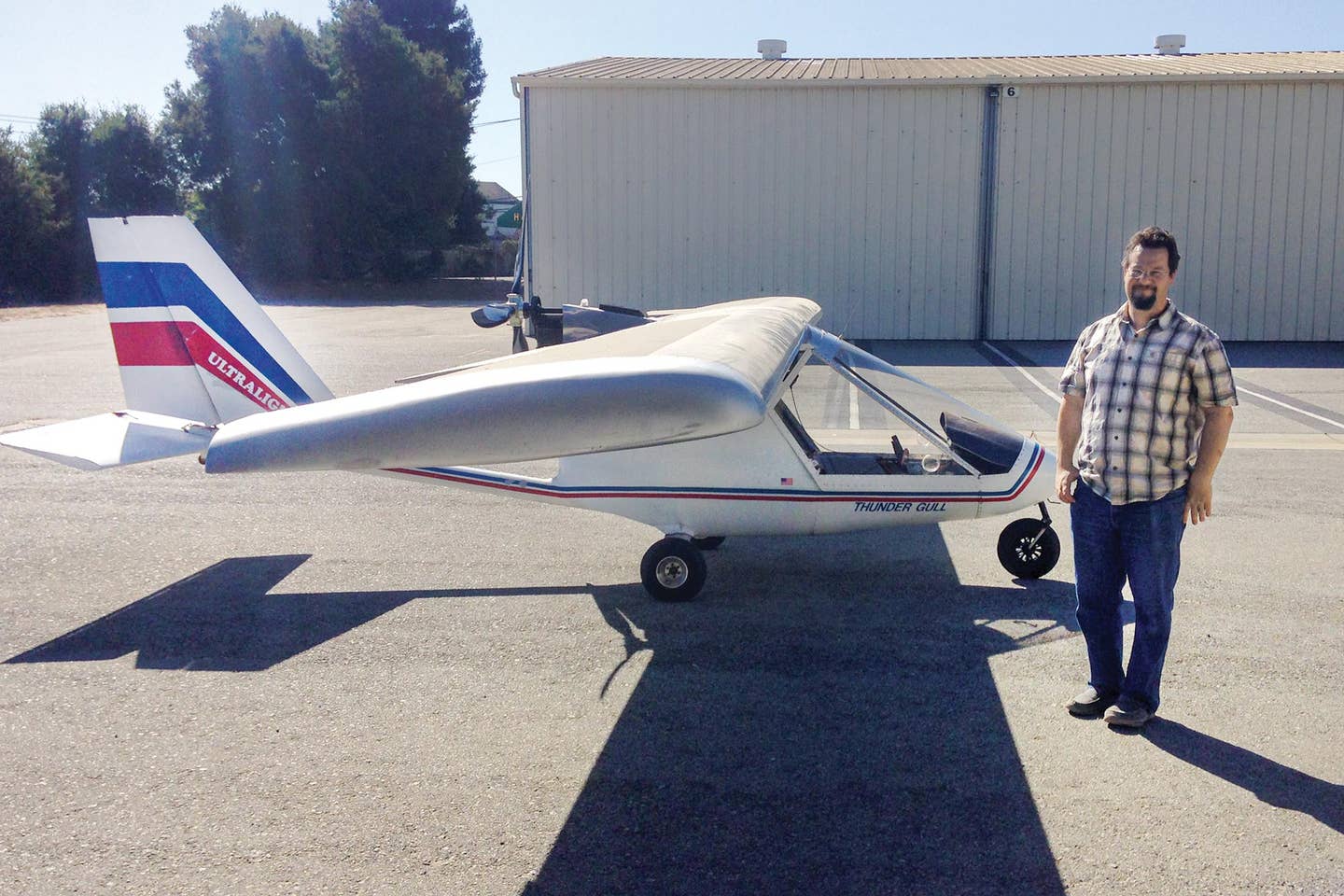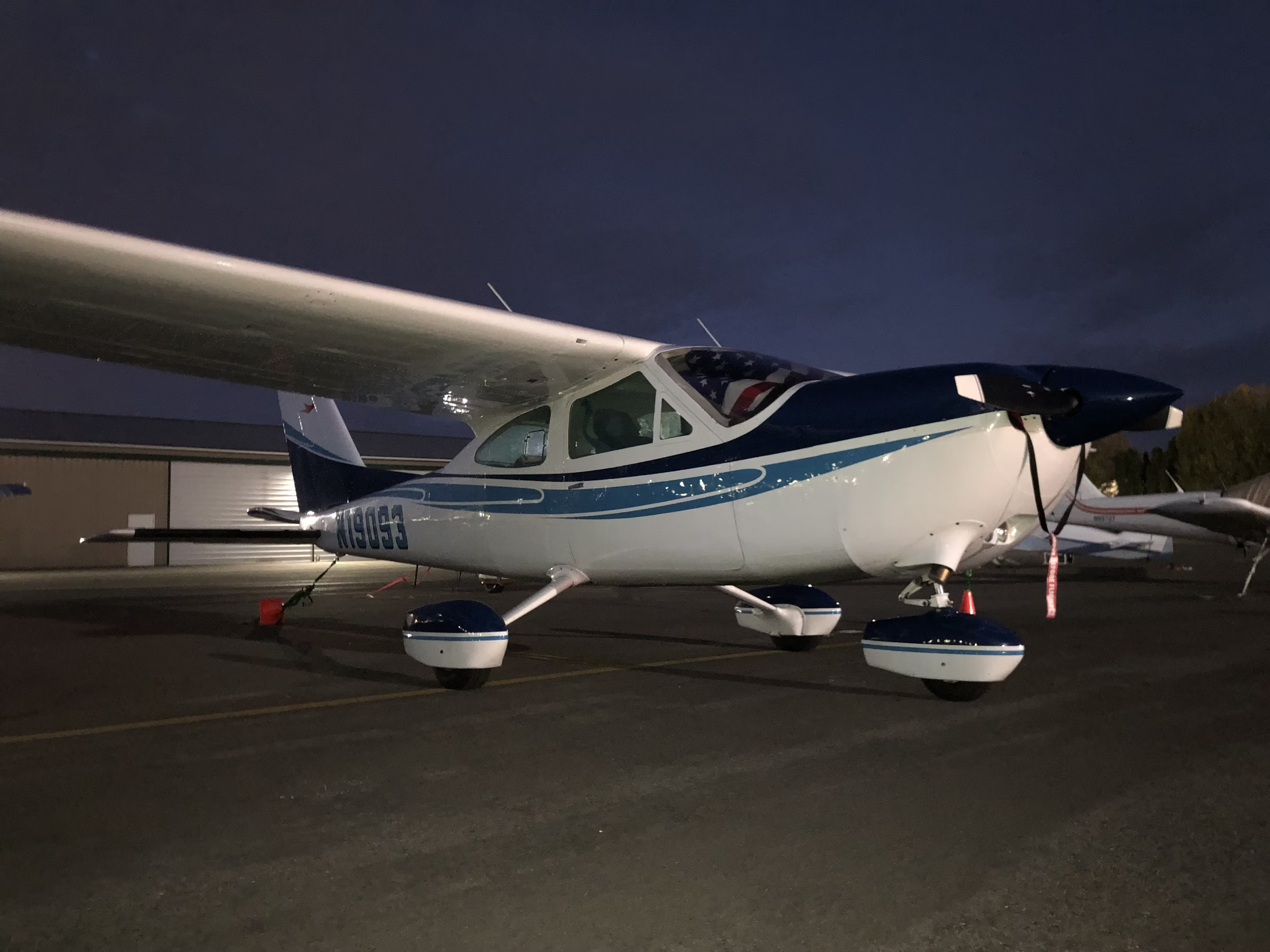
Gabriel DeVault with the electric Thunder Gull. Courtesy Peter Garrison
As I taxi out, a crisp shadow follows on the taxiway beside me. I give a little burst of power, then pull the throttle lever back to idle. Out of the corner of my eye, I see the shadow of the prop stop. “Uh-oh,” I think. “The engine quit.”
But no.
The airplane is a pod-and-boom single-seat ultralight converted by Mark Beierle and Gabriel DeVault to electric power using components from a Zero electric motorcycle. This is the first electric airplane I’ve been in, and I’m learning its peculiarities. One of them is, on the ground, if you pull the throttle—well, power lever—all the way back, the prop stops. You have to be careful of people standing around because when the master switch (or “kill switch”) is on, the motor is on as well, even when the propeller is not moving. It can silently spring to life at an inadvertent bump of the throttle.
The flight instruments are the minimum required and conventional; the powerplant instruments, on the other hand, consist of digital displays showing how much power you have left, how fast you’re using it, and how hot various parts of the system are. Having arrived at the runway, I am briefly frustrated by the lack of anything to do before takeoff. There’s no run-up and nothing to check. Not only that—the airplane, being an ultralight and beneath the notice of the FAA, has no N number. “Ultralight taking Runway 20 for takeoff, straight-out departure,” I report, with a persistent feeling that something is missing.
DeVault has told me that the full-power climb is unexpectedly steep, and the airplane is somewhat nose-heavy, and so, when landing, I should fly it on rather than attempt to stall it on. I retain the first of these warnings and forget the second. He’s right; the angle of climb is impressive, as is the deck angle, and I’m not even using full power. I climb straight out to 1,000 feet and turn northward along the coastline of Monterey Bay in California. It’s a beautiful day, the scenery is lovely, Santa Cruz serenely puffs cannabis in the middle distance. There is no vibration, but the airplane is noisier than I expected. You imagine an electric motor will be practically silent, and maybe it is, but the propeller, chopping its way through the disturbed wake of the pod and wing, isn’t. (DeVault has posted a bunch of in-flight videos that give a good idea of it. Search for “Gabriel DeVault electric airplane” on YouTube.)
Electric cars added the phrase “range anxiety” to our vocabulary. Flying an electric airplane is like flying a conventional airplane when you’re down to the last hour’s fuel. But at least in the electric airplane you know precisely, to two decimal places, where you stand; there’s none of that “Does the width of the needle count?” feeling. DeVault told me to come back when I’m around 30 percent of charge. After 40 minutes in the air, I am there and do. My landing is atrocious. Forgetting I’m not supposed to stall it on, I let the plane develop too much of a sink rate and then find I don’t have the elevator authority to arrest it. After I collide with the runway, an inept dance on the heel brakes ensues. Luckily, the landing gear is pretty stout—DeVault says that Beierle, the airplane’s designer, demonstrates it by veering around on rough ground like an SUV in a TV ad.
Well, I thought, that was fun—except for the end.
The fuel of electric airplanes is kilowatts. The watt is a unit in the metric system—our light bulbs have been metricated all along—and is the power of one volt at a current of one ampere. A kilowatt is 1,000 watts and equals 1 1/3 horsepower. Eventually, you stop having to make conversions, but as a novice, I still multiply kilowatts by 4/3 to get back to familiar territory. (For instance: The 100-watt bulb in my reading lamp draws about 1/7 horsepower.) DeVault’s motor has a peak output of 45 kW (60 hp) but, at that level, will soon overheat; it can run continuously at around half that power, but only 10 kW is required to maintain a stately cruising speed of 55 knots.
The battery capacity is given in kilowatt-hours. It is as if we measured the capacity of fuel tanks in horsepower-hours rather than gallons. A 50-gallon fuel capacity is around 650 hp-hr and will keep you aloft for five hours at an output of 130 hp. The lithium-ion battery, with about one-fiftieth of the per-pound energy capacity of avgas, stores around 11 kWh. Charging time is a function of supply voltage; a 220-volt outlet will top a completely drained battery in an hour, provided a 50-amp circuit is available (because 50 multiplied by 220 equals 11,000). At typical electric rates, the cost of a full charge is $1.20. Alternatively, a 20-by-25-foot patch of solar cells—retail cost around $7,000—will do the same for nothing, assuming the sun is shining.
Read More from Peter Garrison: Technicalities
The motors of electric airplanes are much lighter and more compact than comparable internal combustion engines. Their power output is limited by, among other things, rpm—which, in aviation applications, can’t exceed around 3,000 because of propeller-tip speed—and importantly, by cooling. Being so compact, electric motors do not have a large surface area to dissipate waste heat; high-performance motors use liquid cooling and sacrifice some of the advantage of their small frontal area to the need for a radiator.
The electric motor’s throttle is its “controller,” which looks like an old-fashioned hi-fi amplifier with cooling fins. The controller works by interrupting the flow of electricity from the battery to the motor with fast solid-state switches. The more power you ask for, the more of the time the switches are “on.” The tempo of the switching is so rapid, the flow of power appears to be continuous.
As everyone knows by now, lithium-ion batteries have just enough energy per pound to permit flight, if at only low speeds and for short distances. Partisans of electric airplanes regularly predict imminent increases in battery capacity, but for the moment, what gets from a battery to the propeller is about one-fifteenth, per pound, of what we get from avgas. There are battery chemistries that are considerably more power-dense than lithium-ion but lack its virtues of rapid rechargeability and long useful life.
(The difference between the one-fiftieth I mentioned earlier and the one-fifteenth in the previous paragraph is the fact that electric motors are about three times more efficient than piston engines.)
I have it on good authority that no fewer than 230 companies, worldwide, are developing one kind or another of electric aircraft. Many of these are of the short-range, multirotor, VTOL, urban-taxi variety, for which electric propulsion is uniquely suitable. How suitable pure electric—as opposed to hybrid—systems prove to be for other kinds of aircraft will depend on still-unforeseeable developments in battery technology. Where there’s a will, there’s a way—but it might be a long way.
This story appeared in the March 2020 issue of Flying Magazine

Sign-up for newsletters & special offers!
Get the latest FLYING stories & special offers delivered directly to your inbox






